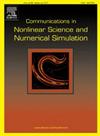Symbolic dynamics approach to find periodic windows: The case study of the Rössler system
IF 3.4
2区 数学
Q1 MATHEMATICS, APPLIED
Communications in Nonlinear Science and Numerical Simulation
Pub Date : 2024-10-24
DOI:10.1016/j.cnsns.2024.108403
引用次数: 0
Abstract
Modification of a parameter of a chaotic system may lead to the emergence of a periodic attractor. Under certain assumptions periodic windows (regions in the parameter space in which a periodic attractor exists) densely fill a chaotic region. Usually it is very difficult to prove this property. In this work, we propose a systematic procedure to locate and prove the existence of periodic windows. The method combines the symbolic dynamics based approach to find unstable periodic orbits (UPOs), the continuation method to locate periodic windows (PWs), and interval arithmetic tools to prove their existence. The proposed method is applied to the Rössler system. The existence of several thousands of PWs close to the classical parameter values is proved and periodic attractors very close in the parameter space to the classical Rössler attractor are found. Estimates of measures of sets of parameters for which a periodic attractor exists are calculated.
寻找周期窗口的符号动力学方法:罗斯勒系统案例研究
修改混沌系统的参数可能会导致周期性吸引子的出现。在某些假设条件下,周期窗口(参数空间中存在周期吸引子的区域)会密集地填充混沌区域。通常很难证明这一特性。在这项工作中,我们提出了一种定位和证明周期窗口存在的系统程序。该方法结合了基于符号动力学的方法来寻找不稳定周期轨道 (UPO)、延续方法来定位周期窗口 (PW),以及区间算术工具来证明它们的存在。所提出的方法被应用于罗斯勒系统。证明了数千个接近经典参数值的 PW 的存在,并发现了在参数空间中非常接近经典罗斯勒吸引子的周期吸引子。计算了存在周期性吸引子的参数集的度量估计值。
本文章由计算机程序翻译,如有差异,请以英文原文为准。
求助全文
约1分钟内获得全文
求助全文
来源期刊

Communications in Nonlinear Science and Numerical Simulation
MATHEMATICS, APPLIED-MATHEMATICS, INTERDISCIPLINARY APPLICATIONS
CiteScore
6.80
自引率
7.70%
发文量
378
审稿时长
78 days
期刊介绍:
The journal publishes original research findings on experimental observation, mathematical modeling, theoretical analysis and numerical simulation, for more accurate description, better prediction or novel application, of nonlinear phenomena in science and engineering. It offers a venue for researchers to make rapid exchange of ideas and techniques in nonlinear science and complexity.
The submission of manuscripts with cross-disciplinary approaches in nonlinear science and complexity is particularly encouraged.
Topics of interest:
Nonlinear differential or delay equations, Lie group analysis and asymptotic methods, Discontinuous systems, Fractals, Fractional calculus and dynamics, Nonlinear effects in quantum mechanics, Nonlinear stochastic processes, Experimental nonlinear science, Time-series and signal analysis, Computational methods and simulations in nonlinear science and engineering, Control of dynamical systems, Synchronization, Lyapunov analysis, High-dimensional chaos and turbulence, Chaos in Hamiltonian systems, Integrable systems and solitons, Collective behavior in many-body systems, Biological physics and networks, Nonlinear mechanical systems, Complex systems and complexity.
No length limitation for contributions is set, but only concisely written manuscripts are published. Brief papers are published on the basis of Rapid Communications. Discussions of previously published papers are welcome.
 求助内容:
求助内容: 应助结果提醒方式:
应助结果提醒方式:


